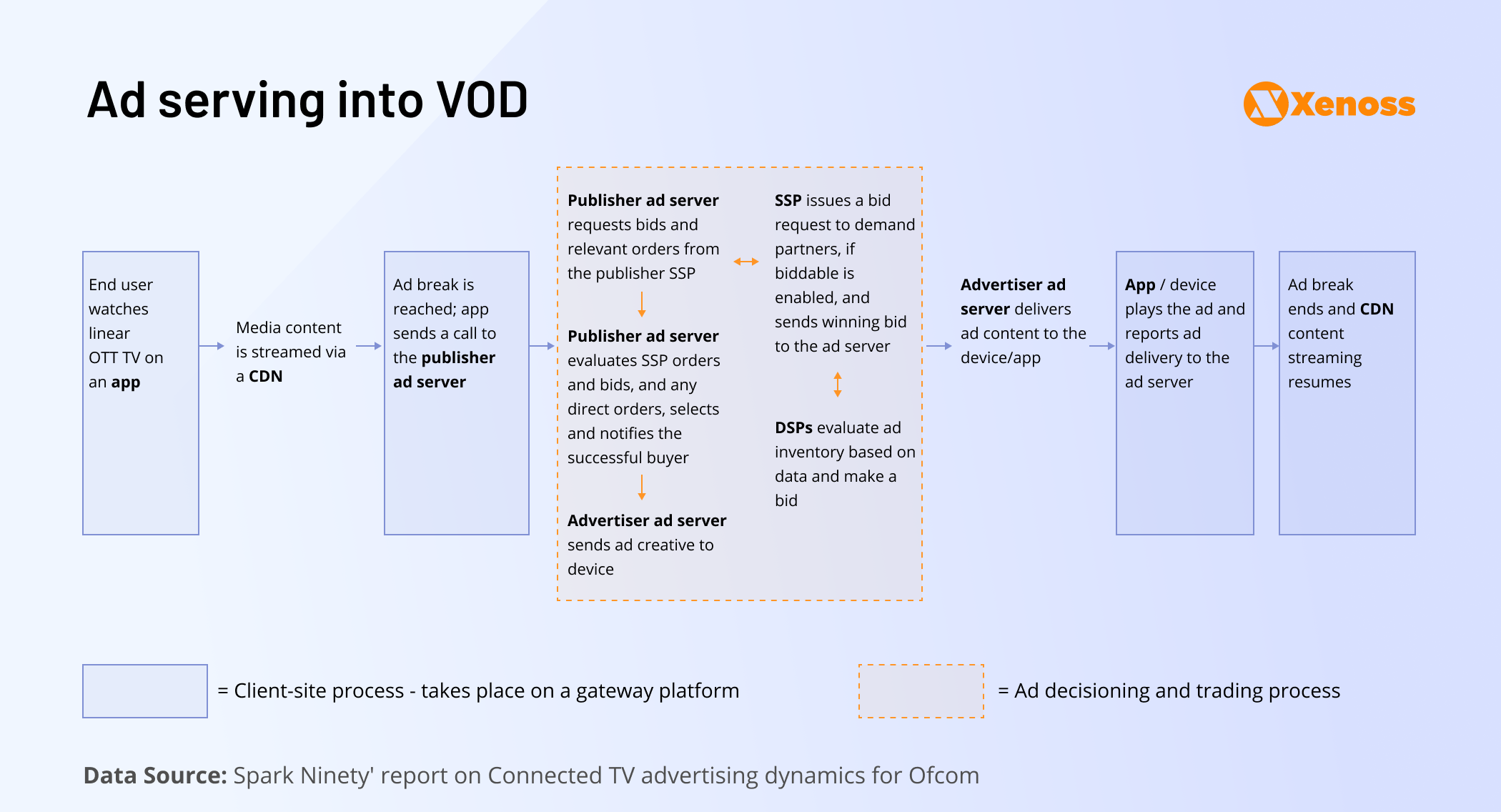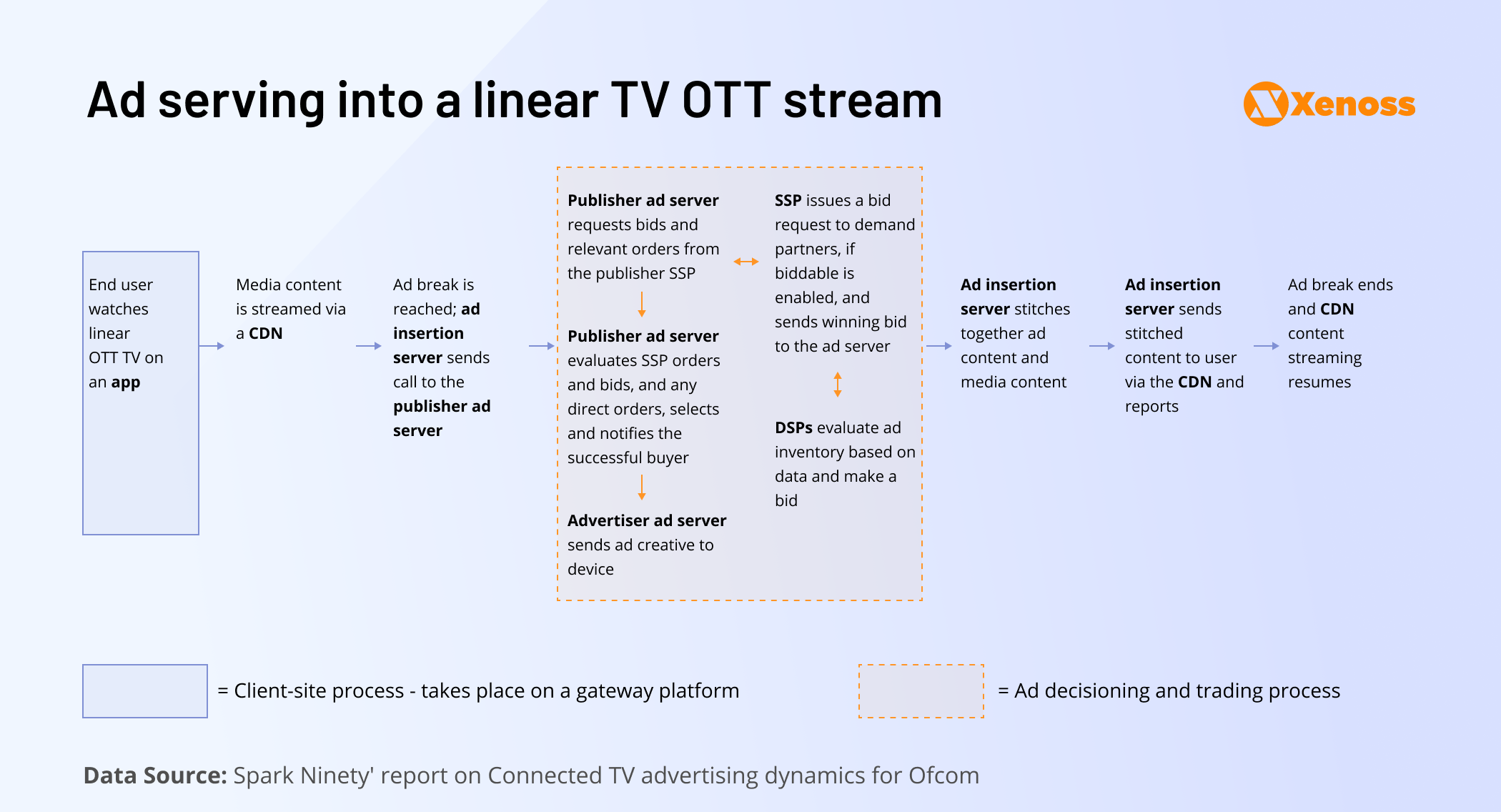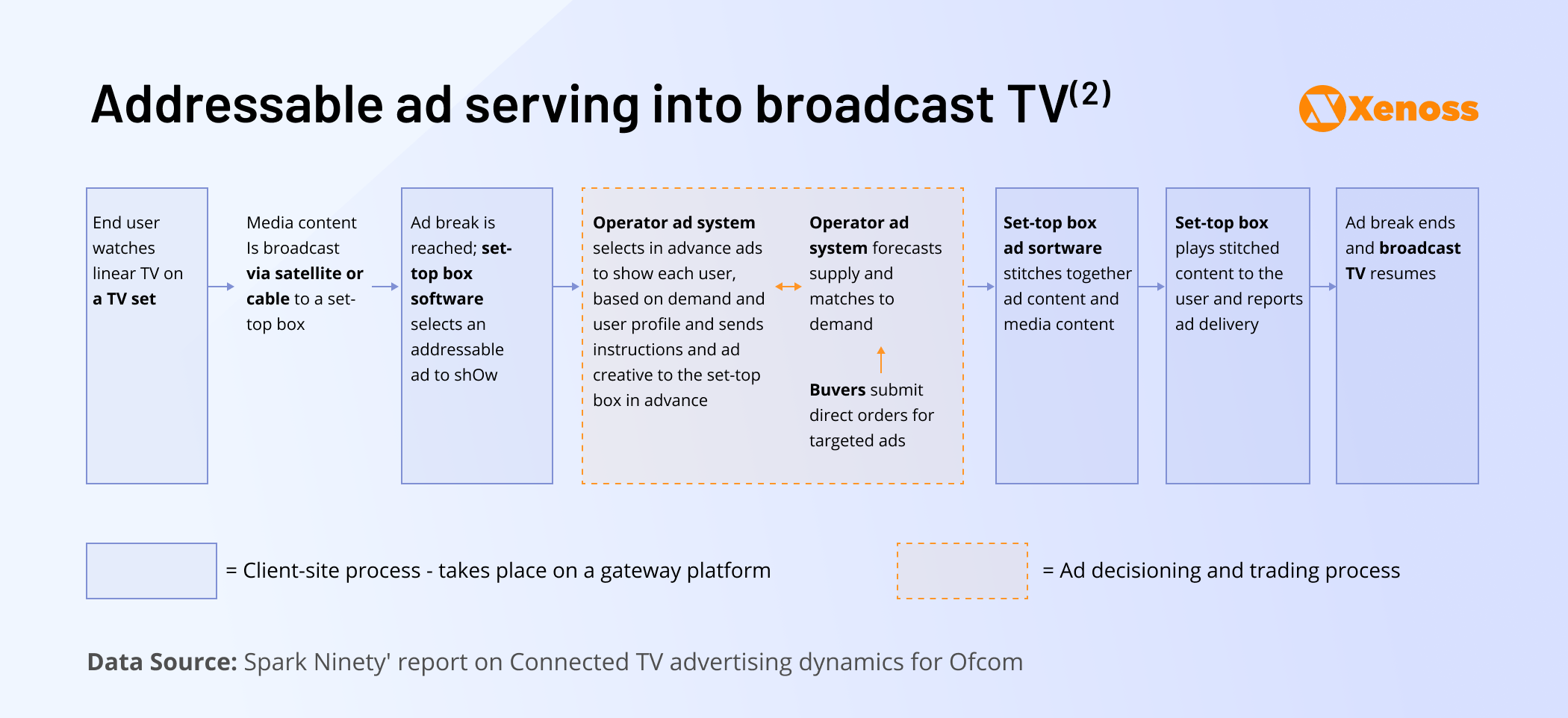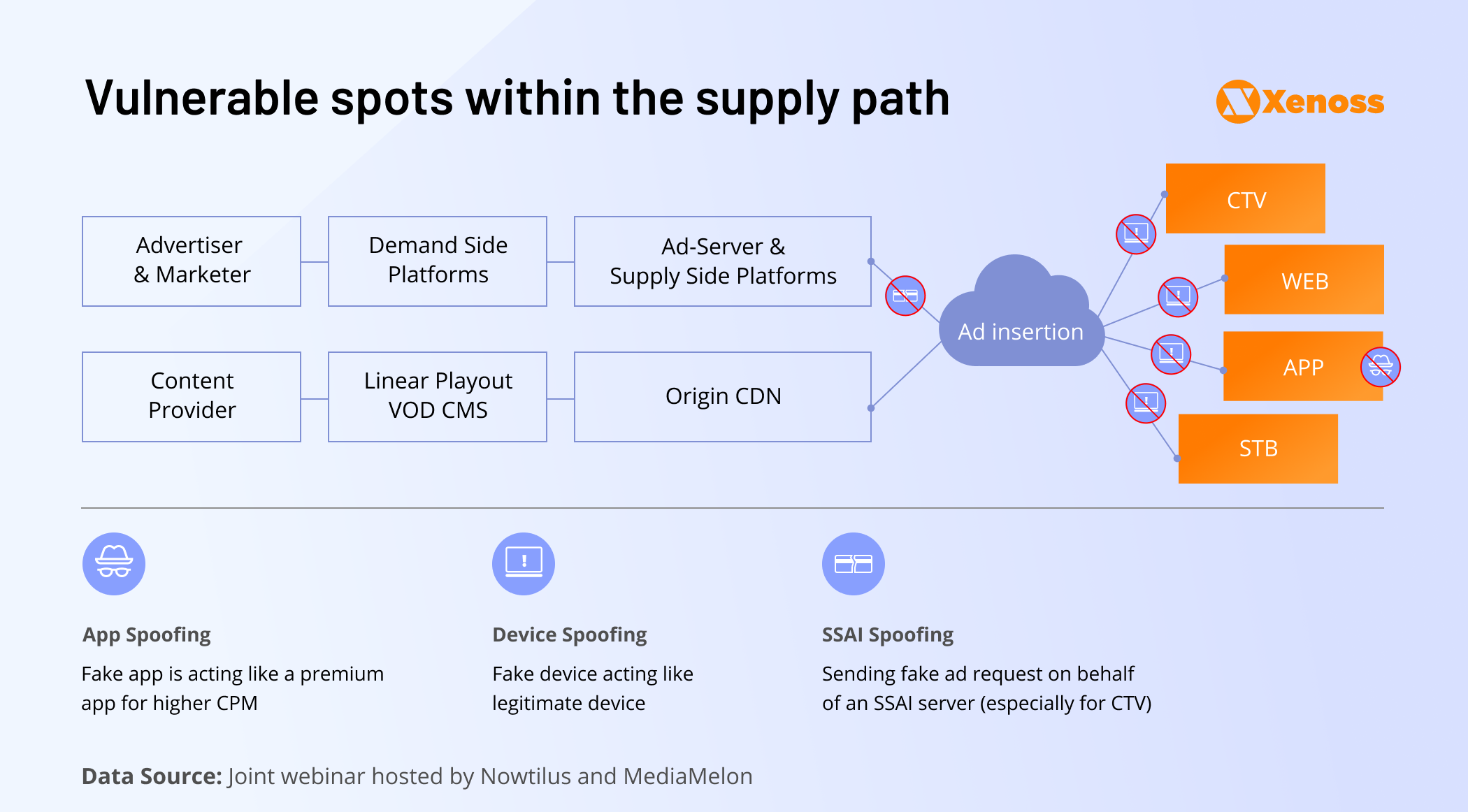Connected TV ads are overtaking linear advertising. CTV advertising is growing 32% faster than total media overall and is set to hit $22.7 billion by the end of 2024, according to the IAB Digital Video Ad Spend & Strategy Report.
But it’s also facing some hurdles due to a fragmented value chain (which lends extra complexities to CTV measurement).
The ownership of key CTV ad inventory, data, and enabling technology is generally split among four groups: buyers (advertisers and media agencies), AdTech companies (DSPs, SSPs, direct buying platforms, and ad servers), media owners (ad sales houses and content services), and getaway platforms (streaming apps, CTV devices, and operating systems).
With that, CTV ad serving technology is now a centerpiece in publishers’ operations.
How CTV ad server technology works
A CTV ad server processes bids, selects offers, and handles ad delivery on the gateway platform (a user device or a video viewing app). It also helps with audience targeting and processes programmatic placements from buy-side platforms, including direct deals.
Typically, a CTV value involves two types of ad servers: a publisher server (first-party server) and an advertiser ad server (third-party server).
Publisher server (first-party ad server) manages orders from the publisher SSP, selects the best bids, secures ad creative from the advertisers, and inserts it in a purchased slot. It also determines the most suitable ad formats, timing, and placements for the highest video monetization.
Two scenarios are possible for ad insertion: client-side ad insertion (CSAI) and server-side ad insertion (SSAI).
- CSAI ad requests and ad stitching happen on the viewer’s device. This method allows targeting based on available user data and real-time personalization of CTV video ads.
- SSAI ad requests and ad stitching occur server-side. Video and ad content are delivered together in a single encoded stream from the video ad server to the video player.
Advertiser ad server (third-party ad server) supplies the creative to the publisher and reports on successful ad delivery. Analytics includes viewability metrics, ad completion rates, impression tracking, and attribution analysis.
The best CTV ad servers also provide extra features for campaign performance optimization, like behavioral or contextual ad targeting or frequency capping best practices.
Both technologies can be used in different CTV advertising scenarios.
Ad serving into VOD streaming
In a typical programmatic VOD advertising scenario, an AVOD/SVOD app calls the publisher ad server when the ad break approaches. The publisher ad server receives bids and direct orders from the publisher SSP. The ad server selects the best offer(s) based on rules like price floors or ad category filters and notifies the buyer.
The publisher ad server may also share additional data like program ID, ad break type, or creative format requirements. The advertiser ad server sends ad content either to the user’s device or to the ad insertion server, which plays the ad and reports ad delivery.

Ad serving into linear TV OTT stream
In linear OTT video monetization, a dynamic ad insertion server sends a call to the publisher ad server. Then the process is the same as with VOD: the publisher ad server selects the winning bid and obtains the creative. An ad insertion server stitches ad content and media content, and delivers it to the user via the CDN.
The process can involve both SSAI for seamless integration into live content and CSAI for greater ad personalization, which allows broadcasters to gain the best monetization without hindering users’ CTV experience.

Addressable ad serving into broadcast TV
The serving process for addressable TV advertising is slightly different. Broadcasters insert signals into their content stream (usually based on the SCTE 35 protocol or OAR Watermark) to mark an ad break. When the set-top box (STB) detects this message, it requests instructions from an ad decision system (ADS). An ADS selects which ads to show to users (based on their profile and demand data) and sends instructions and ad creative to the set-top box (STB) in advance. The set-top box ad software plays the ad and reports to ADS on ad delivery. You can see how the three models differ below.

How to build an ad server for CTV: Features to implement
To protect their ad inventory, a growing number of media owners are building out self-serve video advertising platforms to distribute premium inventory via direct and programmatic guaranteed sales. In such cases, an ad server is a key technology as it allows media owners to share addressable audience data, track conversions, and share measurements.
Smaller publishers are also using white-label ad servers to streamline deal flow, enable better ad delivery experiences for users, and deliver better analytics — all while maximizing CPMs. At the same time, private marketplace (PMP) deals are also emerging as a backfill option, and some companies are cautiously experimenting with open exchange trades.
Support for direct sales and programmatic auctions
Three-quarters of CTV advertising deals are now done programmatically. Programmatic direct and programmatic guarantees remain the most preferred trade methods, although PMP deal volumes are also on the rise, as we previously reported in our CTV market trends post.
A good video ad server must support all trade scenarios, helping publishers manage all their supply and demand partners from one interface and maximize their fill rates at the best price.
You’ll need to create the optimal algorithms for deciding which partners get called first and how often, plus provide users with controls to set custom rules and exclusions.
Ad serving with VAST tag
CTV ad servers serve ads directly into video streams, handling targeting and measurement. A key piece of technology behind that is the video ad serving template (VAST), developed by IAB.
A VAST ads tag is an XML file, containing metadata about the ad, such as ad media files, duration, click-through URLs, tracking URLs, etc. It may also include several ad versions, adapted for different devices and CTV operating systems. By using the tag, the video player can fetch and playback various ad formats, plus it tracks and reports different events like view start, complete, and CTR to the ad server to then deliver reports on impressions and engagement.
The latest VAST Version 4.3 also allows embedding third-party scripts for viewability and ad verification.
SSAI ad serving
Server-side bid processing means all ads get stitched into content before they go up on a viewer’s device. Since ad markers are embedded into a video stream, SSAI enables programmatic ad serving in live broadcasts, as well as AVOD and FAST channels.
Client-side ad insertion (CSAI) has always been challenging due to high device fragmentation. It’s also not always effective for live broadcasts due to higher latency. SSAI reduces the lag between ad server calls and device response with ad podding. An ad pod is a bundle of ready-to-be-served ads to be shown across available ad slots during the break. Part of the OpenRTB 2.6 release, it enables publishers to create linear TV-like advertising experiences in CTV.
Publishers can serve structured ad pods with a fixed number of slots, each with a predefined duration, or dynamic pods, where the total ad break duration is fixed, but the total number of slots is flexible. A hybrid pod has a combination of the above.
Publishers can better monetize streaming services with per-pod bidding. Smaato found that eCPMs for podded ad inventory were 3X higher than for non-podded inventory. Moreover, ad podding enables better competitor separation, allowing publishers to avoid having two ads from the same IAB category in the same pod, and promotes creative deduplication, leading to better outcomes for the advertisers. Since ads are stitched in advance, buyers can also run extra brand safety checks and enjoy greater transparency.
Frequency capping
Frequency capping is important to avoid user fatigue and dwindling ad engagement. But the CTV market doesn’t offer enough of it: 30% of marketers and publishers say that better frequency capping would increase their CTV advertising spend.
In many cases, legacy TV networks and CTV gateway platforms don’t provide an adequate volume of data to implement effective caps via a DSP. Ad serving technology can help address this frustration by sharing extra data with buy partners like:
- CTV device IDs
- Household IDs
- Ad impressions timestamps
- Ad campaign metadata
- Content metadata
IAB just launched an Ad Creative ID Framework, which introduced unique identifiers for CTV ad creatives that can be transmitted via VAST tags. This data can help buyers make more informed decisions.
At the same time, some market leaders are also leveraging AI for CTV ad frequency capping and deduplication. Publica launched Elea.ai — a real-time ad recognition system that identifies brands on video ads in real-time. It also supplies the IAB category and advertiser domain for each ad and helps publishers auto-construct the optimal ad pods.
Fraud prevention
The number of CTV fraud variants annually has tripled since 2020, according to DoubleVerify. Unprotected CTV advertising campaigns have an average 11.2% fraud rate against 0.6% for protected campaigns.
Common fraud scenarios for CTV include bot traffic, SSAI fraud, device spoofing, browser spoofing, and malicious CTV apps. SSAI fraud is particularly nasty as fraudsters can generate completely fake traffic by creating their own servers or using cloud resources to amp up the impression count. Because measurement doesn’t happen on the CTV device such fraud is harder to detect and thus requires more modern ad fraud prevention solutions.

Generally, an ad server must perform device authentication, geolocation verification, and timestamp verification in ad requests and interactions to minimize the odds of fishy requests. You should also include IVT detection and blocking features and viewability verification to ensure all impressions are legit. Magnite’s SpringServe has several verification partner integrations for delivering measurement insights. Furthermore, the platform provides reach and frequency reporting so that media owners can see how many unique impressions are being served.
Privacy and consent management
CTV advertising must comply with global privacy laws and consent management frameworks. The Video Privacy Protection Act (VPPA) is the most important, yet challenging one in the US.
VPPA applies when personally identifiable information (PII) is connected to viewership data without consent. Effectively, it requires publishers to separate viewership data from granular ad call data that contains IP addresses and mobile ad IDs as such attributes can point back to a specific user. In other words: Streaming companies can’t share both a user ID and show-level information in a programmatic bid request.
NBCU, for example, only informs advertisers about the top 10 performing shows for their CTV campaigns based on aggregate viewership, not deterministic device IDs. Tubi also only gives aggregate reporting on its campaign’s top-performing shows.
From January 2024, CTV publishers in the EU and UK must comply with Consent Framework v2.2, which mandates using a certified consent management platform (CMP). TCF v2.2 extended greater control to users over data collection and publishers — a wider range of options to collect consent. But, the diverse range of CTV OS and lack of standardized protocols makes compliance a bit more challenging.
In both cases, your ad server must be configured in a way that ensures that all ads are served in line with user privacy preferences and legal regulations.
Takeaways
CTV ad servers are an essential tie in the CTV AdTech stack, powering buy and supply-side data exchanges, plus seamless ad delivery on user devices. With features like dynamic ad insertion, ad podding, competitive separation, frequency capping, and price-per-second optimization, CTV ad servers help publishers boost ad viewability, improve measurements, and maximize their inventory value without hindering user experience.


